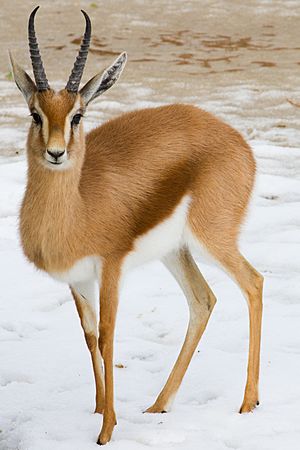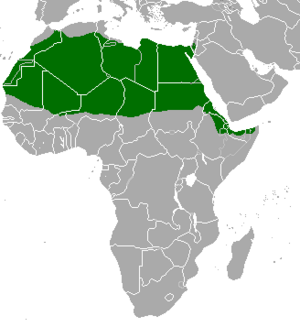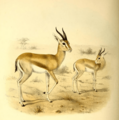Ariel gazelle facts for kids
Quick facts for kids Dorcas gazelle |
|
|---|---|
 |
|
| In Marwell Zoo, UK | |
| Conservation status | |
| Scientific classification | |
 |
|
| Gazella dorcas range | |
| Synonyms | |
|
Capra dorcas Linnaeus, 1758 |
The dorcas gazelle (Gazella dorcas), also called the ariel gazelle, is a small and common type of gazelle. These gazelles are about 55 to 65 centimeters (21 to 26 inches) tall at the shoulder. Their body and head are about 90 to 110 centimeters (35 to 43 inches) long. They weigh between 15 and 20 kilograms (33 to 44 pounds).
Dorcas gazelles live in different places like grasslands, steppes, dry riverbeds called wadis, and desert areas. You can find them in parts of Africa and Arabia. There are about 35,000 to 40,000 dorcas gazelles living in the wild today.
Contents
About the Dorcas Gazelle
Scientific Name and Family
The scientific name for the dorcas gazelle is Gazella dorcas. It belongs to the group of animals called Gazella, which are all gazelles. They are also part of the Bovidae family, which includes animals like cows, goats, and sheep.
The first person to describe this animal was a Swedish scientist named Carl Linnaeus. He wrote about it in his book Systema Naturae in 1758.
Different Types of Dorcas Gazelles
Scientists have found six different types, or subspecies, of the dorcas gazelle. Each subspecies might look a little different or live in a specific area.
- G. d. subsp. beccarii – Eritrean dorcas gazelle
- G. d. subsp. dorcas – Egyptian dorcas gazelle
- G. d. subsp. isabella – Isabelle dorcas gazelle
- G. d. subsp. massaesyla – Moroccan dorcas gazelle
- G. d. subsp. osiris – Saharan (or Saharawi) dorcan gazelle
- G. d. subsp. pelzelnii – Pelzeln's gazelle
- †G. d. subsp. saudiya – Saudi gazelle (This type is now extinct, meaning it no longer exists.)
What They Look Like
The dorcas gazelle looks a lot like the mountain gazelle, but it is smaller. Dorcas gazelles have longer ears and horns that curve outwards, then turn inwards and forwards at the tips.
Gazelles living in the Sahara desert have very pale, light brown coats. Their bellies are white, with a brown stripe above the white. Their faces and foreheads are a bit darker than their bodies. Gazelles from north of the Sahara often have a more yellow-brown color. They also have dark stripes on their sides and faces. Those living in Israel and near the Red Sea are usually darker and more reddish.
In the past, the number of dorcas gazelles went down in many places. Today, you can find large groups of them in the Negev desert and the Arava valley in Israel. There are also many in Sudan and the southern part of the eastern desert in Egypt. In Israel, there are only about 1,000 to 1,500 gazelles left.
How They Live
Dorcas gazelles are very good at living in the desert. They get most of the water they need from the plants they eat. Even though they get a lot of water from plants, they will still drink water if they find it. They can handle hot temperatures and strong sunlight very well.
They are usually active from evening until morning, especially when it's very hot during the day. In places where people hunt them, they often become active only at night. This helps them stay safe from hunters.
These gazelles eat leaves, flowers, and pods from many types of acacia trees. They also eat leaves, twigs, and fruits from different desert bushes. Sometimes, they stand on their back legs to reach higher branches. After it rains, they have been seen digging up bulbs from the ground.
Dorcas gazelles can run very fast, up to 80 to 96 kilometers per hour (50 to 60 miles per hour). When they feel threatened, they twitch their tails and make bouncy jumps with their heads held high. This behavior is called "stotting." It might be a way to show predators that they have been seen.
Family Life
When food and water are scarce, dorcas gazelles often live in pairs. But when conditions are better, they gather in family groups. These groups usually have one adult male, several females, and their young.
During the breeding season, adult males become territorial. They mark their area with piles of dung. In most places where they live, mating happens from September to November.
A female gazelle is pregnant for about six months. Usually, she gives birth to one baby, called a fawn. Sometimes, twins have been seen in Algeria. Newborn fawns are born well-developed, with fur and open eyes. Within the first hour, the fawn tries to stand up and will drink its mother's milk on its first day.
For the first two weeks, the young gazelle hides in a small dip in the ground or under bushes. Its mother grazes nearby. After about two weeks, the fawn starts to follow its mother and begins to eat solid food. Around three months old, the fawn stops drinking milk and is fully weaned.
Dangers They Face
The number of dorcas gazelles has gone down in many areas. Their natural predators include humans, cheetahs, leopards, Arabian wolves, and lions. However, because of human hunting, there are not many large cats left to hunt dorcas gazelles.
Usually, only sick or weak gazelles are caught by predators. Healthy gazelles are often able to escape. To get away from a cheetah, which is the fastest land animal, they run extremely fast and zig-zag, just like the Thomson's gazelle. Smaller predators like the serval and caracal sometimes hunt young gazelles.
The biggest threat to dorcas gazelles today is the growth of human cities and farms. Their habitat shrinks as land is turned into farmland. Also, new herds of domestic sheep and goats compete with the gazelles for food in the grasslands.
Trade of Gazelle Parts
In Morocco, the fur and horns of dorcas gazelles are sometimes sold. People use them for decorations or for traditional medicine. Even though dorcas gazelles are protected by Moroccan law, they are often seen in markets. Since there are not many wild dorcas gazelles in the country, this trade could be very harmful to their populations.
See also
- Wildlife of Israel
- Mountain gazelle
Images for kids
-
G. d. massaesyla, Souss-Massa National Park, Morocco
-
Horns of a dorcas gazelle (above) and rhim gazelle (below)
-
Dorcas gazelles. Ezuz, Israel












